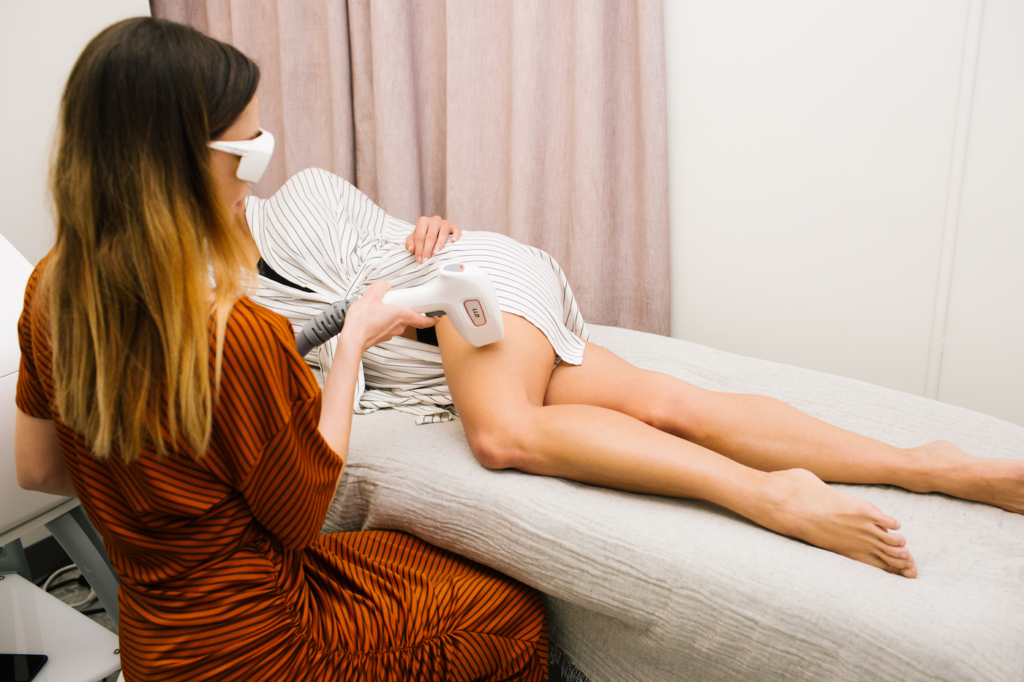If you have fair hair, you can expect the process to take about six to eight sessions before all of your hair is gone. The number of sessions will vary depending on how much hair you have, where it is located, and how thick it is. When getting laser hair removal treatment, it’s important that you do not shave or wax beforehand. This can make the process less effective because it will make the hairs thicker and harder for the laser to reach them.
Laser hair removal is a fantastic way to get rid of unwanted body and facial hair. However, it is important to know that laser hair removal works best on fair hair. The reason for this is that darker skin tones can absorb more light than light skin tones and so the lasers don’t work as well on dark skin.
Read on to learn more about Best Laser Hair Removal For Fine Hair, Laser Hair Removal Risks And Safety and How Long Does Laser Hair Removal Last and What It’s Like To Get Laser Hair Removal?

Best Laser Hair Removal For Fine Hair
Our laser hair removal systems are a popular, non-invasive option to reduce unwanted hair. Unlike other techniques, laser hair removal leaves your skin smooth-textured and without irritation. Treatments typically involve monthly sessions that last approximately 15-30 minutes. We recommend approximately 4-6 treatments to achieve optimal results, with occasional touch-up appointments. The feeling of the laser during treatment is described as a “rubber-band snap” and is very well tolerated. We recommend sun avoidance a few days before and immediately after treatments. We look forward to meeting you and determining if you are a candidate for laser hair removal!
What is Laser Hair Removal?
Laser hair removal is a procedure performed by a trained professional. The process removes hair from the body using a laser. This procedure has been FDA approved for hair reduction and in use since 1997. It works best on trimmed or shaved skin, as there must be a hair in the follicle as a ‘target’ for the laser. Laser heat disables follicles from producing hair. Regardless of what some clinics and spas claim, laser hair removal is not permanent hair removal! However, the treatments produce very significant and long-lasting reduction in coarse body hair.
How does Laser Hair Removal work?
Lasers produce light energy at certain wavelengths that target dark pigment molecules in the hair. Therefore, it works best on dark, coarse hair. The lighter the skin and the darker and more coarse the hair, the better the treatment works. Since the laser targets pigmentation, it is recommended that the skin in the area to be treated with laser NOT be tanned during the time of treatment. If the skin is pigmented (dark, tanned), there is a risk of PERMANENT DISCOLORATION OF THE SKIN in the treated area. Sun avoidance after treatment is also recommended.
Hair on the body grows in cycles, and various hairs go through their growth cycle at different times. Different areas of the body cycle at different speeds, but generally, each area can be re-treated every 4-6 weeks, and approximately 6 treatments are necessary to achieve acceptable results, with maintenance treatments needed 2-3 times per year thereafter.
Will Laser Hair Removal Work for Me?
If you have dark, coarse hair, do not pluck or wax the area you want treated with laser, are committed to regular treatments, and understand that maintenance treatments will likely be needed in the future, then laser hair removal may be for you! Commonly treated areas include: underarm, pubic area, legs, abdomen, lip, chin, back, buttocks, thighs, face, neck, chest, arms, and toes.
What can I expect during and after my treatment?
The laser treatment is very tolerable, many patients describe it as a ‘hot rubber band snap.’ Your provider will choose a test site on your body to determine the appropriate laser settings to use. These settings can be adjusted according to your response as treatment progresses.
An ice pack can be applied before and after the treatment for comfort if needed. Following treatment, shedding of treated hair can take up to three weeks to occur. After this, a hair-free period can last for up to six weeks, at which time resting hair follicles become active and it is time for the next laser treatment.
You will notice how successful the treatments have been after waiting 6 months from your last treatment. New hair growth after this period may be attributable to factors such as hormonal changes, dietary factors, or medical conditions. Maintenance treatments may be needed 2-3 times annually.
What can I do about fine, light hair growth?
Treatment with intense pulsed light (IPL), electrolysis, waxing, dermaplaning, and prescription topical medication (Vaniqa cream) are all options for removal of unwanted fine, light “peach fuzz” hair.
Laser Hair Removal Risks And Safety
Laser hair removal doesn’t guarantee permanent hair removal. Some hair could be resistant to the laser treatment or grow again after treatment – although the new hair growth might be finer and lighter in color.
Possible laser hair removal side effects include:
- Mild swelling around the hair follicles
- Pigment changes may occur, especially in those with darker skin – these changes are usually temporary
- Slight redness of the skin
- Temporary irritation resulting in blistering, crusting, scarring or other changes in skin texture
Special care must be taken for those with darker skin. A less intensive laser should be used to avoid damaging the outer skin.
Anyone who has tanned, used a spray tan or gone to a tanning booth should wait until the tan has faded as the pigment in the skin absorbs the laser light and reduces the effectiveness of the treatment.
These risks and others will be fully discussed prior to your consent. It’s important that you address all your questions directly with your laser hair reduction provider.

How Long Does Laser Hair Removal Last
Every morning, when I’m greeted with the task of shaving my legs, I wish like hell for a solution that’s more permanent. Despite the fact that I know laser hair removal is far-and-away the most lasting option, I’ve never saddled up to try it out for a few reasons: One, I’m a little worried about the pain; two it’s certainly the most expensive option out there, and three, how long does laser hair removal last, anyways? Because, if I’m going to invest the time and money, I want the hair to be gone for-e-ver.
“Laser hair removal uses pulses of light to destroy the hair down to the root,” says Saime Demirovic, co-founder of Glo Spa in New York City (it does this by targeting and destroying the pigment in the hair follicle). “These laser-light pulses create heat which damages the hair follicle until it is permanently destroyed.” (More on that later). “You’re exposing the targeted hair follicle to a high energy beam of light without injuring the surrounding skin structures,” says Leonard Bernstein, MD, board-certified dermatologist with the Laser & Skin Surgery Center of New York. As for what to know about the treatment itself and how long it lasts, keep on reading for all the intel to have before you book your first appointment

What It’s Like To Get Laser Hair Removal?
Though laser hair removal has been around since the mid ’90s, Dr. Bernstein says it’s advanced a lot since then. At his facility, he uses devices like the Clarity II by Lutronic, which he says has many bells and whistles that make it customizable for different people who comes to his office. “Many lasers and Intense Pulse Light (IPL) devices have developed over the past decades, making the elimination of hair a very safe process when performed by well-trained and experienced laser physicians,” he says. To figure out which laser to use on a patient, he takes into account factors such as skin tone, hair color, hair coarseness, tattoos, and past use of certain medications.
Demirovic says you shouldn’t be pregnant to have the treatment done, and you must be off of antibiotics (both topical and oral), for at least one to two weeks before starting laser because otherwise you’re extra sensitive to light and can be burned. The same goes for retinoids, which you should not use for three to five days before the treatment. Keep in mind that if you’re about a week away from starting your period, your skin can be extra sensitive, so you might want to schedule around that for pain’s sake.
Advancements in laser technology have also made laser hair removal much safer for darker skin tones, which hasn’t always been the case. “When laser hair removal first came on the scene, the machines used were IPL lasers and were not designed to treat darker skin tones,” says Demirovic. ” But now, technicians can used the Nd:YAG laser, which operates at a longer wavelength (1064 nm) to remove hair safely in darker skin tones. Alexandrite lasers, by contrast, have shorter wavelengths (820 nm) and are often used to treat lighter skin tones.
Because laser hair removal works by seeking out the darker pigment in the hair follicle than in the skin itself, laser hair removal only works on hair that’s darker than the skin tone itself (sorry, peach fuzz!). “Generally speaking, the density or concentration of pigment in the skin surface is considerably less than the hair shaft, so that the laser light is mainly absorbed by the intended target,” he says.
When you first go for an appointment, Dr. Bernstein says you’ll want to have your natural hair on the surface of skin so that the technician can better evaluate the density, quality, and color of hair. Following that appointment, you’ll want to remove hair prior to visiting your technician. “If there is hair on the surface, the laser will waste its energy burning the hair and won’t be able to reach the root to effectively kill the hair,” says Demirovic.
How long does laser hair removal last?
The truth is that, although laser hair removal is permanent, your hair is still going to grow back eventually. While you might not need a touch-up for two to six years once you’re done with treatments, touch-ups are typically needed at least one to four times a year. Though eventually some hair will grow back, Dr. Bernstein says that it’ll grow back finer and less coarse than what you had before. “We also expect to see a reduction in the density or numbers of active hairs in the treated area,” he says.
Beyond timing, it can also depend on where on the body you’re getting the treatment done. “Areas of coarse hair, such as the lower legs, bikini area, and underarms, respond the fastest while finer facial hair responds the slowest,” says Dr. Bernstein. That said, other factors can influence how long the hair removal lasts. “That would include the energy levels used, the expertise of the laser physician, and underlying conditions of the skin,” he says.
It’s also not a one-and-done sort of deal. After you’re finished receiving all of your sessions, then laser hair removal will last for at least two years; however, maintenance sessions may be needed to keep the area without hair forever.